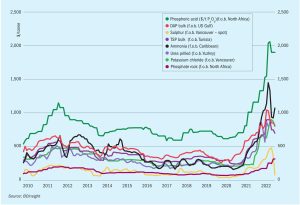
The Atlantic just widened
T he high-price environment for fertilizers and other commodities, including natural gas, is having very different consequences globally.

T he high-price environment for fertilizers and other commodities, including natural gas, is having very different consequences globally.

Some 1,160 delegates from 475 companies and 76 countries gathered in Vienna, Austria, for the 89th International Fertilizer Association (IFA) Annual Conference, 30 May – 1 June 2022. We report on the main highlights of this three-day flagship event.

Applying dissolved fertilizers via micro-irrigation systems or leaf sprayers offers commercial fruit and vegetable growers clear-cut gains – in terms of input costs, nutrient use efficiency, labour, time and energy.

Canpotex is celebrating its 50th anniversary year in 2022. The world’s premier potash exporter has been exclusively marketing and distributing Canadian potash overseas since 1972. In this article, we profile this potash export colossus and look back at its landmark achievements over the past five decades.

Market Insight courtesy of Argus Media

Market Insight courtesy of Argus Media

We compare and contrast the 2021 financial performance of selected major fertilizer producers following the publication of fourth quarter results.

Market Insight courtesy of Argus Media

The war in Ukraine has caused 9,000 civilian deaths and created 5.7 million refugees. If this immense and spiralling human tragedy was not enough, the unprecedented shock inflicted on commodity markets continues to unfold.

More than 745 delegates from 335 companies and 50 countries gathered at the Hilton Downtown, Miami, Florida, 21-23 March, for the Fertilizer Latino Americano 2022 conference. The event was jointly convened by Argus and CRU.